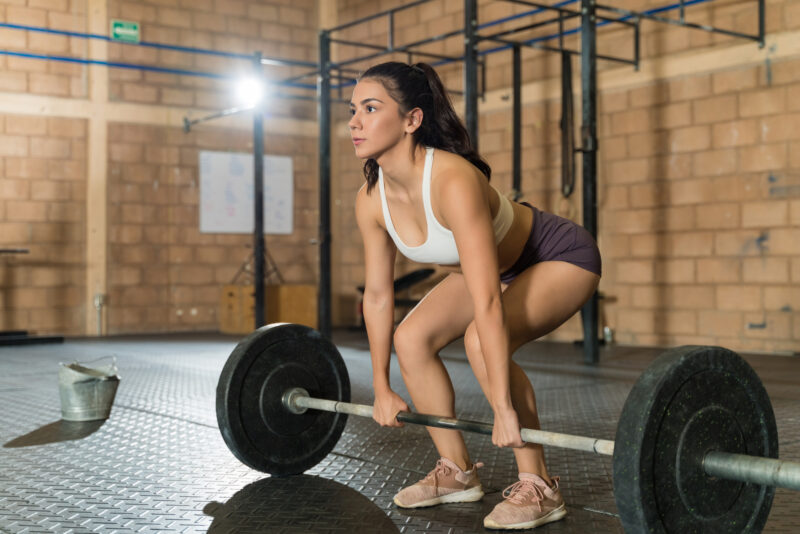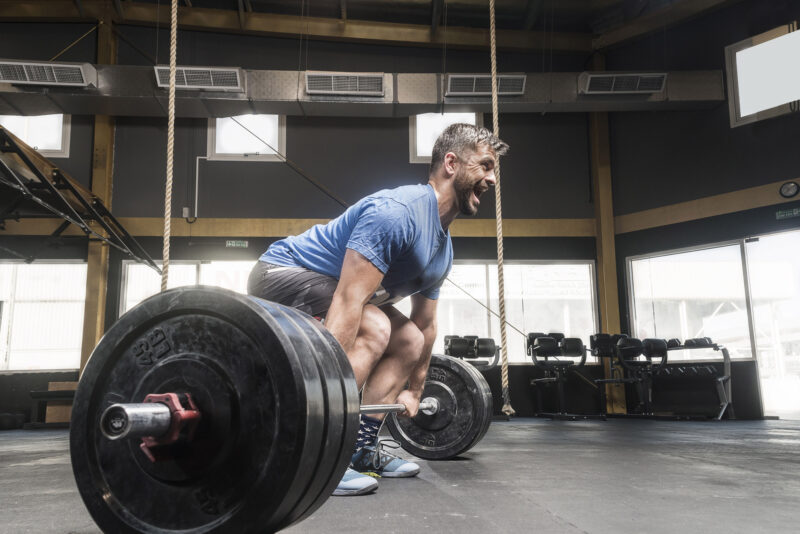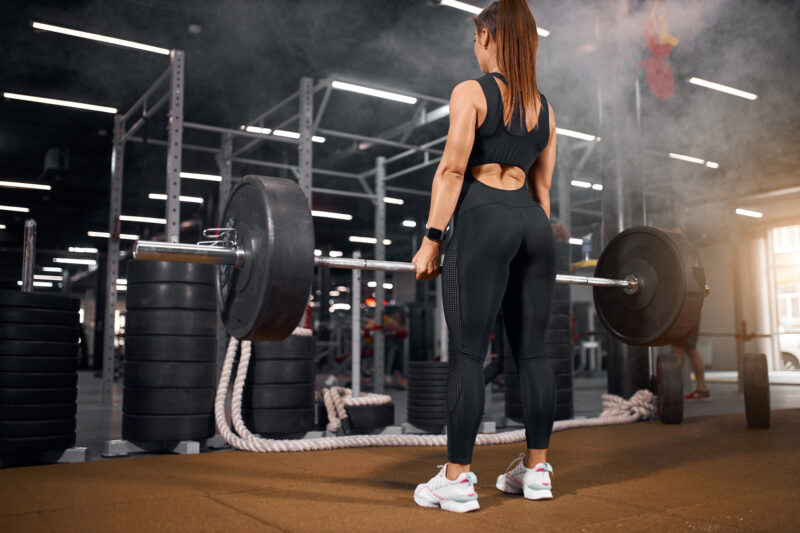Let me ask you something:
What is one of the first pieces of advice you got when you first started lifting weights? Does it include this common gem:
“Lift as much weight as you can.”
If it does and you fell for it, don’t worry. Prevailing wisdom suggests that we need to lift as much weight as humanly possible if we ever hope to achieve good results in the gym.
But, how true is that, especially when it comes to complex exercises like the deadlift?
Let’s see.
So, Do You Have to Deadlift Heavy to Get Results?
No, you don’t have to deadlift heavy. Under the right circumstances, when done correctly, heavy deadlifts can be incredibly beneficial (1). But don’t fall for the myth that you have to deadlift heavy if you want to achieve excellent results in the gym.
As the old saying goes, “There’s more than one way to skin a cat.” For the majority of people who simply want to get leaner, build some muscle, and get a bit stronger, heavy deadlifts are not mandatory.
In fact, unless you can do them with great form, you’d be better off deadlifting lighter weights for more repetitions.
Now, if you aspire to become a powerlifter, then learning how to deadlift heavy is essential – this will be part of your sport. But the most important thing is to do them correctly. There is no point in risking your health and well-being for a few extra repetitions with 300-400 pounds on the bar.
Suggestion: If you are going heavy, you might want some straps. I personally like cobra grips instead. Click this link to check them out on amazon.

A True Story…
You probably have a similar story yourself, but this is something that stood out for me, and it’s been stuck in my mind for many years now.
I was at the gym one morning, and there was just this 18-19-year old kid there doing deadlifts. He started warming up with lighter weights, and his technique was more or less decent.
But, as the weight got heavier, his technique broke down. At one point, he was deadlifting 275 pounds with a belt, and his back was so rounded that I genuinely felt concerned for his health.
At that point – and to this day, really – I’ve asked myself:
“What’s the point in lifting weights when you’re doing that with horrible form and are putting yourself in such a huge risk of injury?”
My point with this story is that you shouldn’t look at training so one-dimensionally. Everything is interconnected, and you should look at all of the variables.
So, by all means, lift heavy weights. But always keep your technique stable and drop the weight a bit if you find that your form is starting to break down.
As Jeff Cavaliere said in one of his videos, “If you can’t control your posture under load, then you’re not really training with a purpose.”
Do You Have to Deadlift At All?
Before we dive into this point, I’d like to emphasize one piece of advice that I got a long time ago and has stuck with me ever since:
There are no mandatory exercises in the gym.
Sure, the deadlift is an excellent exercise, and it helps develop our posterior chain quite well, but you don’t have to do it if you don’t want to or if you can’t (2).
For example, if you’re just looking to get a bit bigger and stronger, there are hundreds of exercises and variations you can use.
If you want to do the deadlift and you don’t suffer from mobility issues, by all means, have at it. But, if you don’t aspire to become a powerlifter, you don’t enjoy the deadlift, and/or your anatomy doesn’t allow you to deadlift safely, then why put yourself at risk?

How to Perform Heavy Deadlifts Safely
If you choose to deadlift heavy, follow these three tips to do so safely:
1) Set Up Properly
How you set up for the deadlift will arguably have the biggest impact on your overall repetition quality, regardless of the amount of weight you have on the bar. Here are the A, B, C’s:
- Set the middle of your feet underneath the barbell. When you look at it from above, the bar should cut your feet in half (we are including the heel). If you do this correctly, the bar will be about an inch away from your shin.
- Bend over and grab the bar with both hands right outside your knee-width. Don’t worry about having your back flat at this point.
- As you’ve grabbed the bar, bring your shins toward it – this will place your hips at the right height.
- Squeeze your chest out and engage your lats. This will flatten your back, straighten your arms and help you pull the slack from the bar.
- Lift the bar in a straight line, having it almost dragging against your shins, knees, and quads.
Throughout the entire set up, you should never move the barbell as that will completely sabotage the whole process. Instead, have the bar in the same spot and adjust your body to it.
2) Don’t Do Touch And Go Deadlifts
Many lifters choose to do touch and go deadlifts because that allows them to throw around heavier weights. But, the problem is, touch and go deadlifts render your initial set up useless.
You see, unless you’re quite the experienced deadlifter, you will need at least the most basic of set-up before each deadlift repetition. If you start bouncing the barbell off the floor between reps, you will lose your set up, and your back will begin to round.
So, as with most things, you have to ask yourself:
“Is this risk worth the potential benefit of doing a few extra repetitions with more weight?”
3) Review Your Technique Often
Many lifters start with proper technique, but then, as they add more weight to the bar, it slowly deteriorates and turns into ego lifting.
So, one of the most beneficial things you can do is review your technique regularly – either make videos of some of your deadlift sets or have a coach review your form. For example, before adding more weight to the bar, see how your technique is holding up. If you feel that you’re not ready yet, stick with that weight for another week or two.

Three Benefits of Heavy Deadlifts
There is no denying that heavy deadlifts offer some benefits. Here are the three most prominent ones:
-
They Strengthen Your Entire Posterior Chain
The posterior chain includes muscles like the trapezius, rear delts, upper back, lower back, glutes, and hamstrings.
The deadlift targets all of them, and helps strengthen them (2, 3, 4, 5). Heavy deadlifts, in particular, are highly beneficial for the lower back, glutes, and hamstrings. Strengthening these muscles is vital for overall strength, speed, explosiveness, athleticism, and injury prevention (6).
-
They Improve Your Grip Strength
A firm grip says a lot about your fitness level. Improving your grip makes you stronger, better able to train with heavy weights, and better able to handle everyday tasks (7).
What’s more, a secure grip, particularly for men, is vital. Having the ability to give a hearty and robust handshake is one of the first things other people will notice about you. A firm handshake gives off confidence, physical strength, and dependability. A weak handshake leaves people with doubt.
What’s more, some research suggests that having a strong grip is tightly correlated with a better quality of life as we get older (8).
-
They Improve Your Functional Fitness
Exercises like the squat, bench press, and pull-up are quite beneficial and improve our functional fitness. But, we can’t argue that the deadlift beats all of them in that regard.
The fact is, being able to pick up something heavy off the ground is incredibly beneficial in our everyday lives.
Conclusion
So, what’s the bottom line here?
Well, the deadlift is quite beneficial, and lifting heavy weights off the floor brings about its fair share of benefits.
But, is it mandatory? No. There is more than one way to get stronger and more muscular, so you should only do deadlifts if you feel confident in your technique, if you have someone knowledgeable to teach you how to do them, and if you find them to be beneficial for you.
Thank you for reading. If you liked this article, please share it and then………. go Pump Some Iron!
Follow me / Pump Some Iron on Instagram for updates @pump.some.iron

